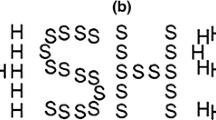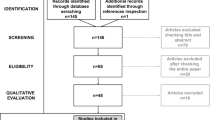Abstract
Research on visual perception in Autism Spectrum Disorder (ASD) tries to reveal the underlying mechanisms of aberrant local and global processing. Global motion perception is one way to study this aspect of ASD. We used plaid motion stimuli, which can be perceived as a coherently moving pattern, requiring feature integration, or as two transparent gratings sliding over each other. If global motion detection is impaired in ASD, this would lead to a decrease of the total time that a coherent pattern is perceived. However, in contrast to other studies in the literature, our results gave no evidence of impaired global motion perception in people with ASD. A reconciliation of the different outcomes is proposed based on spatial frequency processing in ASD.





Similar content being viewed by others
References
Adelson, E. H., & Movshon, J. A. (1982). Phenomenal coherence of moving visual patterns. Nature, 300(5892), 523–525.
Behrmann, M., Avidan, G., Leonard, G. L., Kimchi, R., Luna, B., Humphreys, K., et al. (2006). Configural processing in autism and its relationship to face processing. Neuropsychologia, 44(1), 110–129.
Bertone, A., Mottron, L., Jelenic, P., & Faubert J. (2003). Motion perception in autism: a “complex” issue. J Cogn Neurosci, 15(2), 218–225.
Boeschoten, M. A., Kenemans, J. L., Engeland, H., & Kemner, C. (2007). Abnormal spatial frequency processing in high-functioning children with pervasive developmental disorder (PDD). Clin Neurophysiol, 118(9), 2076–2088.
Boeschoten, M. A., Kenemans, J. L., van Engeland, H., & Kemner, C. (in press) Face processing in Pervasive developmental disorder (PDD): the roles of expertise and spatial frequency. J Neural Transm.
Brosnan, M. J., Scott, F. J., Fox, S., & Pye, J. (2004). Gestalt processing in autism: failure to process perceptual relationships and the implications for contextual understanding. J Child Psychol Psychiatry, 45(3), 459–469.
Castelo-Branco, M., Goebel, R., Neuenschwander, S., & Singer, W. (2000). Neural synchrony correlates with surface segregation rules. Nature, 405(6787), 685–689.
Dakin, S., & Frith, U. (2005). Vagaries of visual perception in autism. Neuron, 48(3), 497–507.
De Jonge, M. V., Kemner, C., de Haan, E. H., Coppens, J. E., van den Berg, T. J. T. P., & van Engeland, H. (2007). Visual information processing in high-functioning individuals with autism spectrum disorders and their parents. Neuropsychology, 21(1), 65–73.
Del Viva, M. M., Igliozzi, R., Tancredi, R., & Brizzolara, D. (2006). Spatial and motion integration in children with autism. Vision Res, 46(8–9), 1242–1252.
Hammond, P. (1991). On the response of simple and complex cells to random dot patterns: a reply to Skottun, Grosof and De Valois. Vision Res, 31(1), 47–50.
Hammond, P., & MacKay, D. M. (1977). Differential responsiveness of simple and complex cells in cat striate cortex to visual texture. Exp Brain Res, 30(2–3), 275–296.
Happe, F., & Frith, U. (2006). The weak coherence account: detail-focused cognitive style in autism spectrum disorders. J Autism Dev Disord, 36(1), 5–25.
Happe, F. G. E. (1996). Studying weak central coherence at low levels: children with autism do not succumb to visual illusions. A research note. J Child Psychol Psychiatry Allied Discip, 37(7), 873–877.
Huk, A. C., & Heeger, D. J. (2002). Pattern-motion responses in human visual cortex. Nature Neurosci, 5(1), 72–75.
Hupe, J. M., & Rubin, N. (2003). The dynamics of bi-stable alternation in ambiguous motion displays: a fresh look at plaids. Vision Res, 43(5), 531–548.
Keil, A., Elbert, T., Rockstroh, B., & Ray, W. J. (1998). Dynamical aspects of motor and perceptual processes in schizophrenic patients and healthy controls. Schizophr Res, 33(3), 169–178.
Lamme, V. A. F. (1995). The neurophysiology of figure ground segregation in primary visual-cortex. J Neurosci, 15(2), 1605–1615.
Lee, S. H., Blake, R., & Heeger, D. J. (2005). Traveling waves of activity in primary visual cortex during binocular rivalry. Nature Neurosci, 8(1), 22–23.
Lord, C., Rutter, M., Goode, S., Heemsbergen, J., Jordan, H., Mawhood, L., et al. (1989). Autism diagnostic observation schedule: a standardized observation of communicative and social behavior. J Autism Dev Disord, 19(2), 185–212.
Lord, C., Rutter, M., & Le Couteur, A. (1994). Autism diagnostic interview-revised: a revised version of a diagnostic interview for caregivers of individuals with possible pervasive developmental disorders. J Autism Dev Disord, 24(5), 659–685.
Miller, S. M., Gynther, B. D., Heslop, K. R., Liu, G. B., Mitchell, P. B., Ngo, T. T., et al. (2003). Slow binocular rivalry in bipolar disorder. Psychol Med, 33(4), 683–692.
Milne, E., Swettenham, J., Hansen, P., Campbell, R., Jeffries, H., & Plaisted, K. (2002). High motion coherence thresholds in children with autism. J Child Psychol Psychiatry, 43(2), 255–263.
Mottron, L., Burack, J. A., Stauder, J. E. A., & Robaey, P. (1999). Perceptual processing among high-functioning persons with autism. J Child Psychol Psychiatry Allied Discip, 40(2), 203–211.
Mottron, L., Burack, J. A., Iarocci, G., Belleville, S., & Enns, J. T. (2003). Locally oriented perception with intact global processing among adolescents with high-functioning autism: evidence from multiple paradigms. J Child Psychol Psychiatry, 44(6), 904–913.
Mottron, L., Dawson, M., Soulieres, I., Hubert, B., & Burack, J. (2006). Enhanced perceptual functioning in autism: an update, and eight principles of autistic perception. J Autism Dev Disord, 36(1), 27–43.
Pellicano, E., Gibson, L., Maybery, M., Durkin, K., & Badcock, D. R. (2005). Abnormal global processing along the dorsal visual pathway in autism: a possible mechanism for weak visuospatial coherence? Neuropsychologia, 43(7), 1044–1053.
Plaisted, K., Saksida, L., Alcantara, J., & Weisblatt, E. (2003). Towards an understanding of the mechanisms of weak central coherence effects: experiments in visual configural learning and auditory perception. Philos Trans R Soc Lond B Biol Sci, 358(1430), 375–386.
Plaisted, K., Swettenham, J., & Rees, L. (1999). Children with autism show local precedence in a divided attention task and global precedence in a selective attention task. J Child Psychol Psychiatry, 40(5), 733–742.
Rinehart, N. J., Bradshaw, J. L., Moss, S. A., Brereton, A. V., & Tonge, B. J. (2000). Atypical interference of local detail on global processing in high-functioning autism and Asperger’s disorder. J Child Psychol Psychiatry Allied Discip, 41(6), 769–778.
Ropar, D., & Mitchell, P. (2001). Susceptibility to illusions and performance on visuospatial tasks in individuals with autism. J Child Psychol Psychiatry Allied Discip, 42(4), 539–549.
Seiffert, A. E., Somers, D. C., Dale, A. M., & Tootell, R. B. (2003). Functional MRI studies of human visual motion perception: texture, luminance, attention and after-effects. Cereb Cortex, 13(4), 340–349.
Spencer, J. V., & O’Brien, J. M. D. (2006). Visual form-processing deficits in autism. Perception, 35(8), 1047–1055.
Spencer, J., O’Brien, J., Riggs, K., Braddick, O., Atkinson, J., & Wattam-Bell, J. (2000). Motion processing in autism: evidence for a dorsal stream deficiency. Neuroreport, 11(12), 2765–2767.
Stoner, G. R., & Albright, T. D. (1992). Neural correlates of perceptual motion coherence. Nature, 358(6385), 412–414.
Thiele, A., & Stoner, G. (2003). Neuronal synchrony does not correlate with motion coherence in cortical area MT. Nature, 421(6921), 366–370.
Welch, L. (1989). The perception of moving plaids reveals two motion-processing stages. Nature, 337(6209), 734–736.
Wickens, T. (2002). Elementary signal detection theory. New York: Oxford University Press.
Acknowledgments
The work described was supported by an Innovational Research Incentives grant (VIDI-scheme, 402-01-094) of the Netherlands Organization for Scientific Research (NWO) to Chantal Kemner. We would like to thank Maarten van der Smagt for his suggestions on the analysis and interpretation of the data.
Author information
Authors and Affiliations
Corresponding author
Rights and permissions
About this article
Cite this article
Vandenbroucke, M.W.G., Steven Scholte, H., van Engeland, H. et al. Coherent versus Component Motion Perception in Autism Spectrum Disorder. J Autism Dev Disord 38, 941–949 (2008). https://doi.org/10.1007/s10803-007-0467-0
Received:
Accepted:
Published:
Issue Date:
DOI: https://doi.org/10.1007/s10803-007-0467-0




